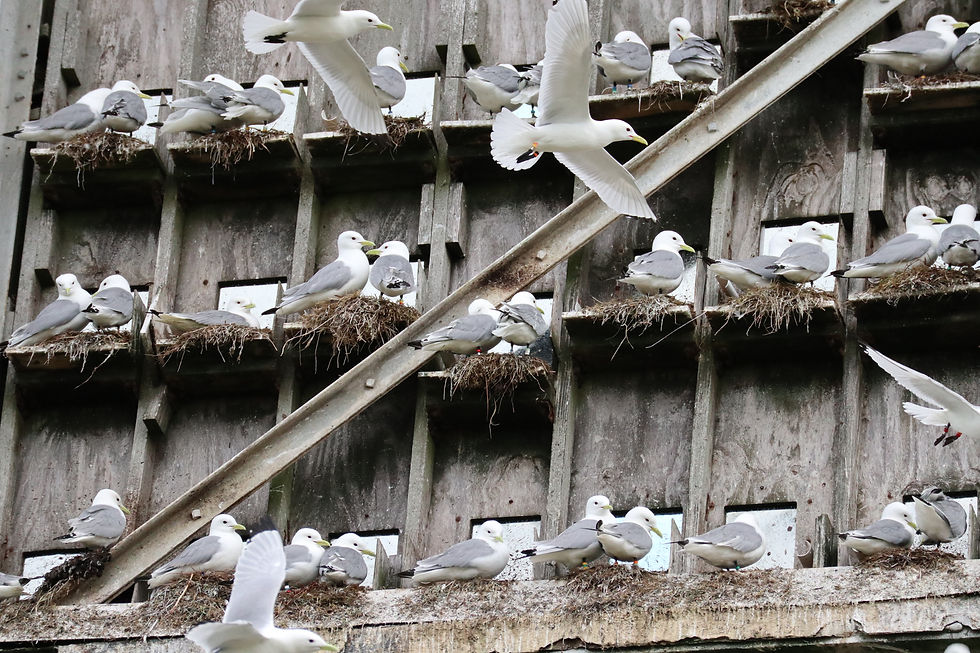Kittiwakes and crumpets on Middleton Island
- SEGUL
- Jun 8, 2019
- 3 min read
Updated: Jun 14, 2019
By Jon Green
I have been lucky enough to work with seabirds in some amazing locations all over the world, but I think it is fair to say that there is nowhere quite like Middleton Island, in the Gulf of Alaska. Last month I spent a week there as a guest of Kyle Elliot, Postdoc Emily Choy and PhD student Shannon Whelan from the Arctic Ecology Lab at McGill University to train them how to deploy heart rate loggers in black-legged kittiwakes. The obvious question is why would I travel to the other side of the world to work with a species that we have here on Puffin Island and around the UK? The obvious answer is that there is no kittiwake colony in the world quite like the one on Middleton Island.

Seabird research has been conducted on Middleton since the 1970s but in 1996, Scott Hatch, then of the USGS but now running the Institute for Seabird Research and Conservation, established a long-term study of the kittiwakes and pelagic cormorants that nested on buildings of an abandoned US Air Force base. He modified the largest of the radar towers to host over 400 pairs of kittiwakes and over 100 pairs of pelagic cormorants which now nest behind removable panels of one-way mirror. This allows the research team unprecedented access to both populations from inside the tower such that the life story of the breeding birds can be recorded in meticulous detail by the annual team of interns. Birds can be captured through panels for sampling or attaching biologgers and chicks can be weighed regularly. Effectively their laboratory is inside their field site, which certainly made the work that we were doing much easier.
But what really makes this place amazing is the ongoing long-term manipulation whereby half of the nesting kittiwakes are provided with supplemental fish, as much as they want to eat, three times a day, throughout the breeding season by the interns. This huge investment of time, effort and fish (over 8 tons per year!) alters the birds’ lives and makes it possible to test a number of ecological and evolutionary ideas, relevant far beyond just the lives of seabirds.
Our work was successful and with Kyle, Emily and Shannon now fully trained we are currently going through the data we obtained from 12 kittiwakes to assess the usefulness of this technique and the loggers that we used. The team on Middleton made me feel very welcome and took time to show me around and tell me what they were up to. I was really struck by their knowledge and passion for what they were doing, even though many of them had not long arrived on the island themselves for the summer season. We captured rhinoceros auklets in some extremely large and extremely complicated burrows as part of a study on oil pollution. At one point four of us were up to our elbows in burrow trying to find a bird. I also heard about projects to study the population of tufted puffins through provision of artificial nest boxes, but sadly for me it was too early in the season for them to be occupied and I had to be satisfied with seeing them wheeling in the sky above instead. I also saw nesting bald eagles, Steller sea lions, loads of rabbits but thankfully no fleas.
Research station life was similar to other places I have worked with the addition of some excellent North American snacks. ‘The Chateau’ provides a comfortable lounge/diner/office/store/lab/workshop while we slept in sturdy tents. My attempt to introduce the team to home-made crumpets was largely a failure, but since most of them had never had an actual crumpet before they at least pretended to be impressed. I liked how they save on washing up by using the same bowl or plate all day – important to make sure you gave it a good lick or rub with a finger between courses.
A week was not long on the island but with the impressive amount of travel required to get there and back it was all that I could squeeze in. Scott and Martha Hatch accommodated me in their amazing home on the way in and out and I am grateful to them not only for that but for introducing me to the mac’n’cheese pizza at the Moose’s Tooth, which is the foodstuff that I and the rest of the world have been waiting for.


























Comments